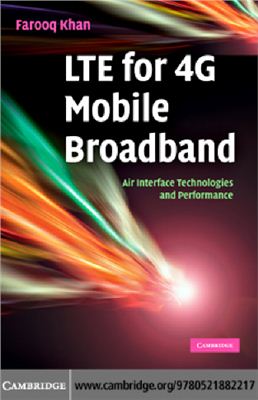Cambridge University Press, 2009
Understand the new technologies of the LTE standard and how they contribute to
improvements in system performance with this practical and valuable guide, written by an
expert on LTE who was intimately involved in the drafting of the standard. In addition to
a strong grounding in the technical details, you’ll also get fascinating insights into why
particular technologies were chosen in the development process.
Core topics covered include:
Network architecture and protocols;
OFDMA downlink access;
Low-PAPR SC-FDMA uplink access;
Transmit diversity and MIMO spatial multiplexing;
Channel structure and bandwidths;
Cell search, reference signals and random access;
Turbo coding with contention-free interleaver;
Scheduling, link adaptation, hybrid ARQ and power control;
Uplink and downlink physical control signaling;
Inter-cell interference mitigation techniques;
Single-frequency network (SFN) broadcast;
MIMO spatial channel model;
Evaluation methodology and system performance.
With extensive references, a useful discussion of technologies that were not included in the
standard, and end-of-chapter summaries that draw out and emphasize all the key points,
this book is an essential resource for practitioners in the mobile cellular communications
industry and for graduate students studying advanced wireless communications.
Understand the new technologies of the LTE standard and how they contribute to
improvements in system performance with this practical and valuable guide, written by an
expert on LTE who was intimately involved in the drafting of the standard. In addition to
a strong grounding in the technical details, you’ll also get fascinating insights into why
particular technologies were chosen in the development process.
Core topics covered include:
Network architecture and protocols;
OFDMA downlink access;
Low-PAPR SC-FDMA uplink access;
Transmit diversity and MIMO spatial multiplexing;
Channel structure and bandwidths;
Cell search, reference signals and random access;
Turbo coding with contention-free interleaver;
Scheduling, link adaptation, hybrid ARQ and power control;
Uplink and downlink physical control signaling;
Inter-cell interference mitigation techniques;
Single-frequency network (SFN) broadcast;
MIMO spatial channel model;
Evaluation methodology and system performance.
With extensive references, a useful discussion of technologies that were not included in the
standard, and end-of-chapter summaries that draw out and emphasize all the key points,
this book is an essential resource for practitioners in the mobile cellular communications
industry and for graduate students studying advanced wireless communications.

